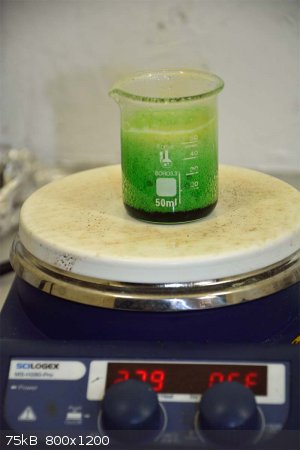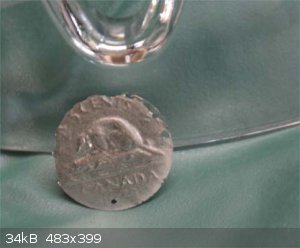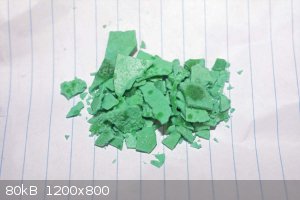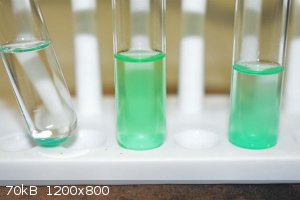| Pages:
1
2 |
JScott
Hazard to Self
 
Posts: 51
Registered: 23-8-2018
Member Is Offline
|
|
Nickel II Nitrate
Hi to all of my new Chemistry friends, a quick introduction:
My favorite Christmas Present? 1969, my first Chemistry set. Gabriel, there were a half dozen after that. I am a hobby nut, but Chemistry has held my
interest longer than any other.
I am an electronics tech by trade. USAF trained electronics countermeasures. An old crow if there are any others out there.
Four years ago I started building a more serious lab space after mucking up a kitchen counter. I've built a fume hood and acquired a nice collection
of glass ware and regents. For the last two years I've hit the books. I wanted to understand what was happening and be able to predict what might
happen.
I keep good notes, take some photos and for the most part learn from YouTube and those text books. Still, things come up and it would be a lot of fun
to talk with others.
Enough intro stuff, among my favorite student experiments was the synthesis of Silver Nitrate. A water soluble white crystal from a metal?!?! WOW, I
was thrilled. From there I started nitrating everything. Lead, mercury, cellulose, rice hulls. I love the color of Copper Nitrate!
Anyhow, no surprises until I tired nitrating nickel. I loved growing copper sulfate crystals and mention how fond I was of the copper nitrate... but
after dissolving a Canadian Nickel (US nickels aren't, wadda ya know) and producing a nice dark green fluid I was unable to dry this solution to
crystals as I had with copper.
Once dried I re hydrated the now light green mass and it dissolved nicely. I tried recrystallizing from water and still, all I get is a dried mass. I
assume I have created Nickel II Nitrate hexahydrate or one of the other hydrated forms.
I don't necessarily want an answer, but I would like to know what I should read. I have done a lot of Googling and have found very little regarding
the wonderful green crystals the wiki has to offer.
|
|
|
fusso
International Hazard
    
Posts: 1922
Registered: 23-6-2017
Location: 4 ∥ universes ahead of you
Member Is Offline
|
|
AFAIK most transition metal nitrates are difficult to crystallize due to the deliquescent nature.
|
|
|
Deathunter88
National Hazard
   
Posts: 507
Registered: 20-2-2015
Location: Beijing, China
Member Is Offline
Mood: No Mood
|
|
Could you elaborate a little more on your drying procedure?
|
|
|
JScott
Hazard to Self
 
Posts: 51
Registered: 23-8-2018
Member Is Offline
|
|
@ Deathhunter88
I'd love to.
I started with a Nickel and it took 30 ml of 60% nitric acid (concentration determined by density) to dissolve the nickel over the course of 45
minutes at 65C. In fact .74 grams of it was left and retrieved. An odd beaver souvenir. It seemed it would never dissolve and I had been adding acid
for a while.
I increased the heat to 80C and in three hours and a few minutes it had reduced to ten milliliters and had a light green crust beginning to form. Some
light green precipitate could be seen. I figured that was about the right time and removed it from the heat. It hardened fairly quickly, so I gave the
now fairly thick surface crust a stir and the darker fluid below it hardened as soon as it hit the air.
Now light green I dissolved it in ten milliliters of distilled water (23C). This I tried evaporating slowly in a bag with Calcium Chloride, in a
vacuum desiccator with silica gel, and in both cases the fluid out lived my patience. A month on the Chloride... oh alright it was three weeks.
I then tried light heat and got the light green mass at the bottom of the dish. This dissolves easily but I have had no luck in creating the larger
emerald green crystals I had hoped for.
@fusso,
Thank you, I have a word to look up, and perhaps a clue! What is AFAIK? Hope that wasn't a too foolish a question ;-)
[Edited on 8-23-2018 by JScott]
|
|
|
fusso
International Hazard
    
Posts: 1922
Registered: 23-6-2017
Location: 4 ∥ universes ahead of you
Member Is Offline
|
|
Oops, used the abbreviation, my bad 
Thats "as far as I know"
[Edited on 23/08/18 by fusso]
[Edited on 23/08/18 by fusso]
|
|
|
JScott
Hazard to Self
 
Posts: 51
Registered: 23-8-2018
Member Is Offline
|
|
@ fusso,
Deliquescent, it may be (normally), but not in the form I have now. Though it is highly soluble, it doesn't form puddles like sodium hydroxide or
calcium chloride.
Thanks for the new word though! Is it a synonym for hydrophilic (how I have, I hope correctly, described the two aforementioned compounds in the
past)?
[Edited on 8-24-2018 by JScott]
|
|
|
fusso
International Hazard
    
Posts: 1922
Registered: 23-6-2017
Location: 4 ∥ universes ahead of you
Member Is Offline
|
|
Quote: Originally posted by JScott  | @ fusso,
Deliquescent, it may be (normally), but not in the form I have now. Though it is highly soluble, it doesn't form puddles like sodium hydroxide or
calcium chloride.
Thanks for the new word though! Is it a synonym for hydrophilic (how I have, I hope correctly, described the two aforementioned compounds in the
past)?
[Edited on 8-24-2018 by JScott] |
Then maybe I should use hygroscopic? I'm not sure.
|
|
|
Dan Vizine
National Hazard
   
Posts: 628
Registered: 4-4-2014
Location: Tonawanda, New York
Member Is Offline
Mood: High Resistance
|
|
What year was the nickel? Only pre-1982 Canadian nickels were nickel
According to someone...
"Canadian nickels were made of 99.9% nickel for many years. From 1982 to 1999 the coin was made of 75% copper and 25% nickel, the same composition as
US nickels. Starting in 2000 the Royal Canadian Mint began phasing in production of the coin using nickel-plated steel."
All of my Canadian nickels are post-2000 and act strongly ferromagnetic.
[Edited on 8/27/2018 by Dan Vizine]
"All Your Children Are Poor Unfortunate Victims of Lies You Believe, a Plague Upon Your Ignorance that Keeps the Youth from the Truth They
Deserve"...F. Zappa
|
|
|
MrHomeScientist
International Hazard
    
Posts: 1806
Registered: 24-10-2010
Location: Flerovium
Member Is Offline
Mood: No Mood
|
|
You may need a stronger drying agent. Nickel nitrate might have a greater affinity for water than calcium chloride or silica. I'd try sodium or
potassium hydroxide next, and if that doesn't work concentrated sulfuric acid is about as good as you can get.
I wonder if you could also crash out crystals by adding acetone to your solution? I did that to prepare hexaaminenickel(II) chloride.
|
|
|
DraconicAcid
International Hazard
    
Posts: 4278
Registered: 1-2-2013
Location: The tiniest college campus ever....
Member Is Offline
Mood: Semi-victorious.
|
|
Nickel(II) nitrate is going to be much more soluble in water than hexaminenickel(II) chloride. Adding acetone to a concentrated solution of it may
very well give you two layers.
Please remember: "Filtrate" is not a verb.
Write up your lab reports the way your instructor wants them, not the way your ex-instructor wants them.
|
|
|
Dan Vizine
National Hazard
   
Posts: 628
Registered: 4-4-2014
Location: Tonawanda, New York
Member Is Offline
Mood: High Resistance
|
|
When you think of drying as a mass transfer issue, you realize that almost nothing is faster than azeotropic distillation. Put your material into a
round-bottom flask with some toluene. Azeotropically remove the water using a Dean-Stark trap. I can't promise that you'll get nice crystals, but
they'll be dry.
The ultimate drying agent is molecular sieves. It'll get things drier than any other drying agent. In a glovebox, molecular sieves can establish an
atmosphere of less than 1 ppm H2O.
[Edited on 8/27/2018 by Dan Vizine]
"All Your Children Are Poor Unfortunate Victims of Lies You Believe, a Plague Upon Your Ignorance that Keeps the Youth from the Truth They
Deserve"...F. Zappa
|
|
|
JScott
Hazard to Self
 
Posts: 51
Registered: 23-8-2018
Member Is Offline
|
|
Very Happy!
I was worried at first, seemed like my discussion wasn't interesting anyone. I am so glad to see all of the replies! Thank you.
@Dan Visine
This nickel was a 1980, you might notice I mentioned how US nickels weren't. How disappointing ;-) I am fairly sure it was in fact a true nickel. I
will try to add pictures of it and the solution. Though I have had a few minor camera problems and don't have a photo (yet) of the finished substance.
Fantastic I was waiting for my first good excuse to purchase a Dean Stark trap. EXCELLENT!!! I will keep you posted on whether or not my problem was
drying. Thank you for the suggestion.
@MrHomeScientist
That also makes good sense. I have used potassium hydroxide to dry my Copper II with great success. I was very surprised how much more hydrophilic it
was! I will do this directly, thank you!
@DraconicAcid
First, if there isn't a draconic acid, there should be!
Next, this is also very easy for me to try during my next lab session. Thank you for the suggestion. I will get back you after I try this... thank you
very much!
|
|
|
FloridaAlchemist
Hazard to Self
 
Posts: 76
Registered: 8-6-2003
Location: USA
Member Is Offline
Mood: No Mood
|
|
Nickel Nitrate Hexahydrate Drying
Using a baking dish . Spread the wet crystals out over the large surface area and dry the crystals in a oven at ~110'C. Cool to room temperature then
quickly crush up the dried chunks and transfer to a air tight container for storage.
|
|
|
JScott
Hazard to Self
 
Posts: 51
Registered: 23-8-2018
Member Is Offline
|
|
@FloridaChemist,
Just to get you caught up, I can 'dry' what I've produced just fine. The problem I am having is that I would like to grow larger, translucent crystals
of Nickel Nitrate as I have other salts.
At this point all of my efforts end in a light green mass at the bottom of the crystallization dish. Water soluble, but I can't get crystals to crash
from this solution. I've got a couple things to try after reading the last few posts here.
I have a few pictures from when I did this last. Sadly I am having a small camera issue and it will be a few days before I can get photos of the
finished product.
Heck of time getting this to post to the right part of the forum. Then I got locked out for "flooding". Maybe it's me... anyone else having issues?
 
[Edited on 8-29-2018 by JScott]
|
|
|
Loptr
International Hazard
    
Posts: 1347
Registered: 20-5-2014
Location: USA
Member Is Offline
Mood: Grateful
|
|
It is more formally known as 4-methoxybenzoic acid.
"Question everything generally thought to be obvious." - Dieter Rams
|
|
|
S.C. Wack
bibliomaster
    
Posts: 2419
Registered: 7-5-2004
Location: Cornworld, Central USA
Member Is Offline
Mood: Enhanced
|
|
Purification of Laboratory Chemicals
Nickel nitrate (6H2O) [13478-00-7] M 290.8, m 57. Crystd from water (0.3mL/g) by partial evaporation in a desiccator.
|
|
|
JScott
Hazard to Self
 
Posts: 51
Registered: 23-8-2018
Member Is Offline
|
|
@DraconicAcid,
very descriptive. I will read up, too cool a name to not be curious
@S.C. Wack,
I have searched what you left me and come up with everything but what I had hoped it would lead to. My apologizes, I am new to this and imagined you
had offered a key to a patent search.
Could you explain a bit more?
|
|
|
Sulaiman
International Hazard
    
Posts: 3555
Registered: 8-2-2015
Location: 3rd rock from the sun
Member Is Online
|
|
Guessing:
Ethanol or IPA may be a better solvent than water for producing hydrated crystals ?
|
|
|
JScott
Hazard to Self
 
Posts: 51
Registered: 23-8-2018
Member Is Offline
|
|
@Sulaiman,
Another great suggestion! This is a richer exploration given all of these new areas to check out.
I had put this on hold, having done the experiment a few times and having not changed my results one smidgen, I was moving on to other things.
All of these new suggestions have encouraged me to reapply myself to this effort.
No later than the start of the new week I will start fresh. I will try all of your ideas, and get back to all of you regarding how it went.
[Edited on 8-30-2018 by JScott]
|
|
|
DraconicAcid
International Hazard
    
Posts: 4278
Registered: 1-2-2013
Location: The tiniest college campus ever....
Member Is Offline
Mood: Semi-victorious.
|
|
Ethanol or methanol, maybe, but isopropanol would probably not work- it salts out too easily.
PS- Draconic acid is also known as p-anisic acid, or just anisic acid.
Please remember: "Filtrate" is not a verb.
Write up your lab reports the way your instructor wants them, not the way your ex-instructor wants them.
|
|
|
S.C. Wack
bibliomaster
    
Posts: 2419
Registered: 7-5-2004
Location: Cornworld, Central USA
Member Is Offline
Mood: Enhanced
|
|
Quote: Originally posted by JScott  | I have searched what you left me and come up with everything but what I had hoped it would lead to. My apologizes, I am new to this and imagined you
had offered a key to a patent search.
Could you explain a bit more? |
Google the subject line of that post. It's not the highest authority but is better than the internet, sounds like solid technique, and suggests you've
been using too much water.
Quite often metal salt hydrates are efflorescent and don't crystallize well in air...or has a tendency to form a basic salt in solution or on
heating...certainly when one warms the solution to evaporate it. Oftentimes in these situations there is excess acid to prevent hydrolysis. How much
relevance that has here or even if the basic salt is soluble IDK.
BTW few of the publisher-scanned volumes of Gmelin are useful, they're usually volumes that have never been opened in a library...but (I noted when
collecting the 184 available volumes) nickel is a rare exception as both the metal and compounds volumes are available...it's probably still not
helpful and a waste of time like mentioning it...it wouldn't surprise me at all if this the most comprehensive paper reference is useless. In any case
it's in German and at gen.lib.rus.ec aka libgen.
[Edited on 30-8-2018 by S.C. Wack]
|
|
|
Sulaiman
International Hazard
    
Posts: 3555
Registered: 8-2-2015
Location: 3rd rock from the sun
Member Is Online
|
|
Nickel passivation in nitric acid
To 'have a go' at crystallising nickel nitrate I first needed some nickel nitrate,
as I have been avoiding nickel chemistry due to toxicity/waste concerns,
I used supposedly pure nickel strips of c 0.3g each so decided to use those,
aware of the possibility of passivation I used 1M nitric acid ... nothing happened
so I heated the acid to boiling ... nothing
added 1.4ml 10% hydrogen peroxide ... nothing
left overnight ... norhing.
added my last c5ml rfna ... nothing
boiled ... nothing
heated a fresh strip of nickel to red/orange heat to try to form an oxide layer
dropped in nitric acid
... vigorous reaction that consumed the entire strip, with plenty of green froth and NO2 produced
removed the original nickel strip, heated to red/orange,
put in acid ... nothing
tried another fresh strip of nickel, heated, ... vigorous reaction
removed the original nickel strip and heated to an orange glow
put in acid ... nothing
tried another fresh nickel strip, heated, ... vigorous reaction
added dH2O to double volume of acid, boiled ... nothing.
as write this the passivated nickel strip is sitting in boiling nitric acid ...
and changing into a brown mud 
I suspect that my 'pure' nickel strips https://www.ebay.co.uk/itm/Pure-Nickel-99-96-Low-Resistance-...
may be iron, plated with nickel. 
A quick test for iron/iron nitrate/iron oxide in the presence of nickel and nitric acid - anyone ?
[Edited on 31-8-2018 by Sulaiman]
|
|
|
JScott
Hazard to Self
 
Posts: 51
Registered: 23-8-2018
Member Is Offline
|
|
@S.C. Wack,
Duh, I did a search on everything but the subject. Thank you, and for the digest of what I will find (when I get to the right place to begin with ;-)
)
@Sulaiman,
Yes, I noted you had begun a nickel experiment on another post. Very good, and a different approach. I always deal with any passivization after the
fact, but didn't think with 60% (sorry haven't done the molar math) I would have a problem. I would have expected it with more concentrated acid.
Ok, a crack at the molar math... would 60% be about 13 mole? Forgive me, a new student fumbling around.
I almost feel as though I cheated. You worked so much harder at then I did... then in the end had been ripped off with crappy nickel! All I had to do
was search through thousands of US nickels and find the Canadian ones I knew would be hiding there. Then, hope they were of the correct linage to be
mostly nickel. I found only four BTW, and two were of the correct date.
[Edited on 8-31-2018 by JScott]
[Edited on 8-31-2018 by JScott]
|
|
|
JScott
Hazard to Self
 
Posts: 51
Registered: 23-8-2018
Member Is Offline
|
|
@S.C. Wack,
Using Duck Duck Go (yes, I'm one of those nuts), I found this pdf. Given the book sells on Amazon for nearly 130$ I thought I would rush over here and
give the URL to all. A great volume for any home chemist I would think.
Don't know if that's what you were leading me to, but THANK YOU! What a super resource, I have a gob of reading to do. With winter coming, the lab
will be too cold to be much fun. A volume of this depth will make the winter months far more enjoyable. Thank you again.
The Purification of Labratory Chemicals, 2009
|
|
|
JScott
Hazard to Self
 
Posts: 51
Registered: 23-8-2018
Member Is Offline
|
|
I had a few minutes this morning to run a small scale experiment to check out some of the suggestions I've gotten. Not anything all that
comprehensive, so don't get too excited ;-)
My first experiments left me with 16.4 grams of "product". This is a bit odd to me as the nickel only weighed approx 3.5 grams. Further, .74 grams
weren't dissolved.
The photo of the small pile is the stuff I made, the result of my efforts to create the wonderful green crystals I've seen made from this nitrate. I
think the darker green dots are areas of more hydrolyzed substance. But I may be using that term incorrectly (it's wetter there).
The test tubes contain, from left to right, toluene, acetone, and ethanol (95%). I dissolved 2 grams (of that aforementioned substance), one gram at
a time into 2ml of distilled water. The first gram dissolved easily in less than 15 seconds. The second gram took nearly a minute to be stirred into
solution. I assumed I was close to the saturation point with this solution.
I added this solution, drop wise, to the three test tubes.
Toluene: it fell to the bottom quickly leaving noting behind in the solvent. It appeared as 'oil in water' on the bottom of the test tube. I shook it
vigorously and it seemed to leave a colorless 'sand like' substance along the side of the test tube, but other than that not much more happened.
Acetone: As it fell through the acetone I noticed a very fine (extremely fine) precipitate and over the course of the first minute it seemed as though
my test solution was fully miscible with the acetone. Here again, explaining what I'm doing to folks who know chemistry, I wonder if I use the jargon
correctly. I mean to say that it seemed to blend fully with the solvent.
Ethanol: This seemed a little more promising. The swirl of solution seemed to 'freeze' momentarily while it fell through the solvent. I had hoped for
a second that it might fall directly to the bottom of the tube as a solid, but alas, this too seemed to be fully miscible in this solvent.
Perhaps my expectations for this precipitation experiment are faulty. Under a best case scenario I was hoping to see my solution turn to a solid when
the drops were added. But, that would be a extreme indication. Perhaps I should be looking for smaller precipitate.
I have left the three tubes to settle some. I will filter the contents and if anything can be learned from that, I'll post my assumptions here... were
they too can be filtered <giggle>
I will, on Monday spend the day on your kindly offered suggestions and advise, and try to get back to each of you in turn to let you know how I am
progressing.
 
|
|
|
| Pages:
1
2 |